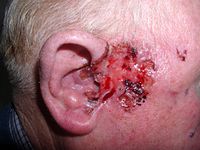
Photo from wikipedia
Introduction: Early repair in patients affected by myelomeningocele (MMC) is of paramount importance in order to prevent infection, minimize neural tissue damage, and reduce mortality. Treatment must include duraplasty and… Click to show full abstract
Introduction: Early repair in patients affected by myelomeningocele (MMC) is of paramount importance in order to prevent infection, minimize neural tissue damage, and reduce mortality. Treatment must include duraplasty and possibly an adequate soft tissue coverage. Delayed surgery in MMC patients can be more tedious due to the less clear borders between the placode and the skin. Moreover, the risks of wound infection and breakdown increase significantly. Case Presentation: We present the unusual case of a large MMC in a 3-year-old patient treated by combining the recently described cryopreserved amniotic membrane (AM) as homograft for dural reconstruction and a bilateral Keystone flap for soft tissue reconstruction. Discussion: Thanks to its anti-inflammatory and elastic proprieties, the AM can play an important role in preventing adhesion between the reconstructed layers, thus reducing the risk of spinal cord tethering. The Keystone flap, at the same time, allows the wound tension to be distributed widely over the flap margins and not only along the midline, which overlies the duraplasty, enhancing the scar quality and lowering the risk of cerebrospinal fluid recurrence and wound dehiscence, with no donor site morbidity.
Journal Title: Pediatric Neurosurgery
Year Published: 2020
Link to full text (if available)
Share on Social Media: Sign Up to like & get
recommendations!